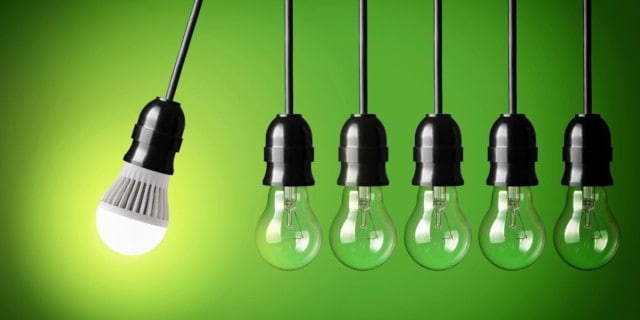LED lights, based on light-emitting diode (LED) semiconductor technology, have been around in various, less sophisticated forms since the early 1960s. While the most ubiquitous association with LEDs likely comes via their use in consumer electronics such as remote controls, microwaves, home entertainment items, etc., since its initial introduction, this technology has taken a quantum leap forward and has been introduced into dozens of new areas of application.
One of the fields in which LEDs are now widely used is high-performance lighting. Their incredible brightness and longevity makes them ideal an ideal lighting solution for the aviation and automotive industries, which have adopted and implemented this technology extensively. One advantageous characteristic of these lights is their rapid rate of “switching”, which makes them extremely useful in communications.

The physical phenomena behind LED lights were known and understood well before any practical applications were introduced. The physics are quite fascinating even to the layman, simply because they’re incredibly cool!
When an electrical current is applied to certain materials, in this case a semiconductor, the electrons in the material recombine and release photons (light) of a given color (depending upon the material). This is called electroluminescence. The various gauges on the dashboards of many vehicles, for instance, utilize semiconductors that light up a Ghostbusters green when electricity is applied, thus allowing you to see your speed, mileage, etc., at night. The material utilized in many modern gadgets, in contrast, releases the characteristic red light with which LEDs are most commonly associated.
One of the first parties to have received a patent for LED technology was a duo of colleagues working at Texas Instruments, who, in the early 1960s discovered that the alloy semiconductor Gallium Arsenide released infrared light when hit with electricity. The LED patriarch, however, was one Nick Holonyak, A GE employee who, in 1962 developed the first highly-visible red LED.
Over time, more and more electroluminescent materials were discovered and applied into LED lighting with the result that LEDs are now available in virtually any color. Additionally, improvements to this technology have resulted in an exquisite level of efficiency, output, heat dissipation and durability. In fact, these parameters have been growing at an exponential rate, which particularly since the introduction of the white LED (which is in actuality a combination of yellow and blue lights), this technology is quickly supplanting other light sources such as fluorescent and incandescent lighting.
These lights, even older models, can last for decades if operated within the prescribed parameters. Many lights that were put into service in the seventies and eighties are alive and kicking today. It is uncommon, however, for these lights to simply die out. Instead, they will typically produce less and less light as they degrade, slowly losing their usefulness.
Temperatures also influence the operational efficiency of LEDs. Particularly warm temperatures, for example, can cause signal reduction and a failing of the device. In contrast, LEDs actually perform better in the presence of colder temperatures. This is why LED lighting is now being widely implemented for cold-dependent applications such as walk-in freezer units. In this environment, the light lasts longer and produces little heat compared to other forms of lighting. This is actually an interesting engineering problem that is currently being researched, since LEDs operating at cold temperatures become frosted and consequently, provide less light. Current investigations into this area will pay off for many industries that carry out operations requiring high-intensity lighting in cold, sometimes freezing temperatures.
Many omnipresent devices utilize LED lighting including:
- Certain night lamps
- Backlights for various displays
- Pager and cell phone devices
- Electronic thermostats
- Newer-generation advertising billboards
LEDs consume less power than their CFL and neon cousins and for this reason are seeing a wide adaptation across many different industries. As LEDs continue to evolve into more efficient, brighter, lighter models, we are sure to see the eventual phasing out of “older” light sources and their replacement with this new generation of lighting.
Comparing LEDs with other lighting
Fluorescent lights – These lights utilize a mercury vapor medium through which electricity is passed in order to give off UV light. This light gets converted by a phosphor to visible white light. These lamps are more efficient than incandescent models but still lose much of their efficiency in the conversion of UV to visible light. One major downside of this type of lamp is that it relies upon mercury, exposure to which is extremely unhealthy. These lamps also last longer (10-20 thousand hours) than incandescent bulbs but are several times more expensive initially.
Incandescent lights – Incandescent bulbs use a filament to produce light. The filament is heated to an extremely high temperature, which causes it to glow and produce light in the visible spectrum. The characteristic color of a fluorescent bulb is yellowish. Only a small fraction of the energy outlay is emitted as visible light; the great majority is dispersed as heat. While these bulbs are cheap to manufacture, they only last about one thousand hours and produce a good bit of heat.
There are so many different types of LEDS including LED grow lights, LED Christmas lights, led lights for cars, led tail lights, led rope lights, strip, flood, bar, super bright, trailer, submersible, for homes, motorcycle, icicle, rgb, string, fog, emergency, spotlight, battery powered and MUCH more! …Needless to say, this technology is absolutely exploding!
There’s simply no doubt that while the initial investment in LED lights may be higher, the lights are more efficient, cooler, more environmentally friendly and pay for themselves in a matter of years.
LED Lighting Earns Coveted Energy Star Mark
LED lighting technology is growing at a geometric rate, with doublings in output and longevity occurring roughly every 3 years! This technology’s exquisite technical virtues are also what make it an incredibly energy efficient form of lighting.
Led light bulb
In fact, the Environmental Protection Agency (EPA), a sub-agency of the US Department of Energy, has bestowed the coveted Energy Star mark onto many LED lighting fixture to designate particularly energy-thrifty units. The guidelines for this award take into account a healthy list of criteria that and hopeful applicants are required to furnish extensive documentation on each of the required conditions and conduct testing on a given sample size of lights:
Lamps Per Watt (LPW) – this metric indicates the quantity of lamps per watt permitted on approved fixtures and is a measure of the total system efficiency.
Lamp Life – This measure requires lamps shipped with fixtures to last at least 10,000 hours, a span of time that LEDs greatly outperform.
Lumen Maintenance – This metric details how bright a light remains after a given period of time. In this case, at least 4,000 hours must be accrued by the sample lamps and they must retain 80% luminosity at 40% lamp life.
Color Rendering Index – This tests the degree to which a given light source will show the colors of objects compared to an “optimal” light source. This is also known as CRI.
Correlated Color Temperature – Color temperature is the temperature of an optimal black body radiator which gives off light of a similar hue to that of the light source.
Lamp Start Time – This is the time required once the lamp is switched on to start and remain on. This measure must be 1 second at the very most, on average.
Power Factor – This is the proportion of real power going to the load to the apparent power within the actual circuit.
Current Crest Factor – This is also known as the Peak to Average Power Ratio (PAPR) and measures, in decibels, a given waveform.
Maximum Measured Ballast Case Temperature during Normal Operation Inside Fixture
Electromagnetic and Radio Frequency Interference.
This list goes on for quite a while and is only applicable to indoor lighting fixtures! Suffice it to say that in order to earn an Energy Star mark, it takes a very excellent product, designed with utter immaculacy. LED lighting represents progress in not only the technological aspects but in its ability to do more with less, which is a growing concern in the industrialized world the more that we discover that the byproducts of industry are often deleterious to the environment and long-term scalable and sustainable strategies are in desperate need of ubiquitous reception and adoption.


